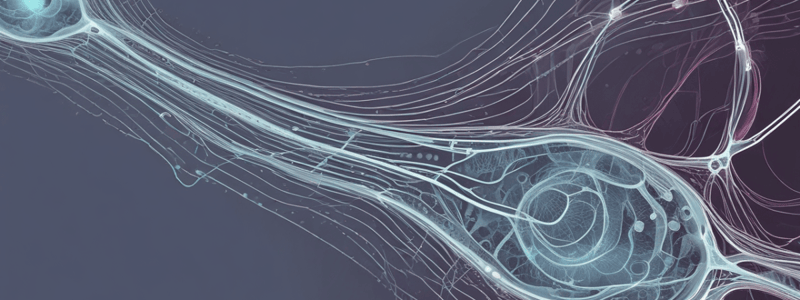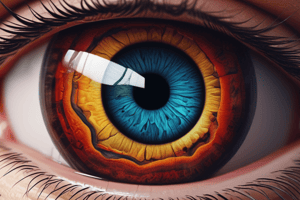Podcast
Questions and Answers
What is the main function of photoreceptor cells in the retina?
What is the main function of photoreceptor cells in the retina?
- To project an inverted image onto the retina
- To regulate the size of the pupil
- To focus light waves onto the retina
- To transduce visible light energy into electrical signals (correct)
What is the purpose of changing the shape of the lens in the eye?
What is the purpose of changing the shape of the lens in the eye?
- To project an inverted image onto the retina
- To focus light waves onto a specific point on the retina (correct)
- To detect static or dynamic mental images
- To regulate the amount of light entering the eye
What is the result of the image projected onto the retina?
What is the result of the image projected onto the retina?
- An inverted image (correct)
- A static image
- An upright image
- A dynamic image
What is responsible for promoting lens accommodation for near vision?
What is responsible for promoting lens accommodation for near vision?
What is the role of the pupil in the visual process?
What is the role of the pupil in the visual process?
What is the purpose of the visual process?
What is the purpose of the visual process?
What is the function of the ciliary muscle in the eye?
What is the function of the ciliary muscle in the eye?
What is the outcome of the brain's visual processing?
What is the outcome of the brain's visual processing?
What is the minimum distance required for the eye to be set for distance vision?
What is the minimum distance required for the eye to be set for distance vision?
What is the term for the process of changing the shape of the lens to focus on closer objects?
What is the term for the process of changing the shape of the lens to focus on closer objects?
What is the function of the ciliary muscles in the eye?
What is the function of the ciliary muscles in the eye?
What is the effect of relaxation of the ciliary muscles on the lens?
What is the effect of relaxation of the ciliary muscles on the lens?
What is the function of the suspensory ligaments in the eye?
What is the function of the suspensory ligaments in the eye?
What is the effect of aging on the lens?
What is the effect of aging on the lens?
What is the function of the photoreceptors in the retina?
What is the function of the photoreceptors in the retina?
What is the difference between rods and cones?
What is the difference between rods and cones?
What is the process of converting light stimuli into electrical stimuli called?
What is the process of converting light stimuli into electrical stimuli called?
What is the function of the dark pigment in the retinal epithelial layer?
What is the function of the dark pigment in the retinal epithelial layer?
What is the effect of light absorption on the photopigment?
What is the effect of light absorption on the photopigment?
What is the function of the optic nerve in the visual pathway?
What is the function of the optic nerve in the visual pathway?
What is the role of the visual cortex in the visual process?
What is the role of the visual cortex in the visual process?
What is the purpose of accommodating the lens shape?
What is the purpose of accommodating the lens shape?
What type of images are formed on the retina?
What type of images are formed on the retina?
What is responsible for changing the shape of the lens?
What is responsible for changing the shape of the lens?
What is the relationship between the parasympathetic ANS and lens accommodation?
What is the relationship between the parasympathetic ANS and lens accommodation?
What is the significance of the distance of 20 feet in the context of vision?
What is the significance of the distance of 20 feet in the context of vision?
What is the result of the light entering the eye?
What is the result of the light entering the eye?
What is the role of the photoreceptor cells in the visual process?
What is the role of the photoreceptor cells in the visual process?
What is the purpose of the visual process?
What is the purpose of the visual process?
What is the difference between the image projected onto the retina and the final mental image?
What is the difference between the image projected onto the retina and the final mental image?
What is the function of the ciliary zonules?
What is the function of the ciliary zonules?
What is the effect of contraction of the ciliary muscles on the lens?
What is the effect of contraction of the ciliary muscles on the lens?
What is the main function of the lens in the eye?
What is the main function of the lens in the eye?
What is the term for the loss of elasticity of the lens with age?
What is the term for the loss of elasticity of the lens with age?
What is the function of the optic nerve in the visual pathway?
What is the function of the optic nerve in the visual pathway?
What is the site of phototransduction in the photoreceptors?
What is the site of phototransduction in the photoreceptors?
What is the result of the activation of photopigments during light absorption?
What is the result of the activation of photopigments during light absorption?
What is the function of the dark pigment in the retinal epithelial layer?
What is the function of the dark pigment in the retinal epithelial layer?
What is the process of converting light stimuli into electrical stimuli called?
What is the process of converting light stimuli into electrical stimuli called?
What is the result of the decrease in cGMP in the photoreceptors?
What is the result of the decrease in cGMP in the photoreceptors?
Flashcards are hidden until you start studying
Study Notes
Mechanism of Image Formation on the Retina
- The visual process involves detecting and translating light into mental images through photoreceptor cells (rods and cones) in the retina.
- These cells transduce visible light energy into electrical signals that pass to the visual cortex.
- The light entering the eyes is altered by changing the size of the pupil and light waves are focused on the retina by changing the shape of the lens (accommodation).
Accommodation of the Lens
- The lens must change shape to focus on closer objects, and this is achieved through the ciliary muscle.
- Parasympathetic ANS promotes lens accommodation for near vision.
- The ciliary body controls the shape of the lens through ciliary muscles.
- Relaxation of the ciliary muscle results in no accommodation, while contraction results in accommodation for near vision.
Retinal Anatomy
- The lens focuses light on the retina, which is a neural layer of the eye.
- The lens is transparent and jelly-like in youth but becomes hard and opaque with age (cataract).
- Light must pass through several layers before reaching photoreceptors in the retina.
- Ganglion cell axons form the optic nerve.
Photoreceptors (Rods and Cones)
- Rods are responsible for black and white vision, while cones are responsible for color vision.
- Light must pass through the dark pigment epithelial layer, which absorbs stray light and reduces reflection.
- Disks in rods and cones are the site of transduction, mediated by pigments.
Phototransduction
- Phototransduction is the process of converting light stimuli into electrical stimuli.
- Photoreceptors hyperpolarize on light absorption, generating a graded potential.
- The graded potential is transmitted to the ganglion cell, which fires an action potential.
Photo Pigment
- A photo pigment consists of two parts: opsin (an integral protein) and retinal (a vitamin A derivative and light-absorbing part).
- The structure of the photo pigment changes during light absorption.
Responses of Photo Pigments
- In the dark, photo pigments have a high concentration of cGMP, leading to membrane depolarization and release of inhibitory neurotransmitters.
- In light, photo pigments are activated, leading to membrane hyperpolarization, closure of Na+ channels, and decrease in cGMP.
- This process results in the generation of a graded potential in bipolar cells and ultimately, an action potential in the ganglion cells.
Mechanism of Image Formation on the Retina
- The visual process involves detecting and translating light into mental images through photoreceptor cells (rods and cones) in the retina.
- These cells transduce visible light energy into electrical signals that pass to the visual cortex.
- The light entering the eyes is altered by changing the size of the pupil and light waves are focused on the retina by changing the shape of the lens (accommodation).
Accommodation of the Lens
- The lens must change shape to focus on closer objects, and this is achieved through the ciliary muscle.
- Parasympathetic ANS promotes lens accommodation for near vision.
- The ciliary body controls the shape of the lens through ciliary muscles.
- Relaxation of the ciliary muscle results in no accommodation, while contraction results in accommodation for near vision.
Retinal Anatomy
- The lens focuses light on the retina, which is a neural layer of the eye.
- The lens is transparent and jelly-like in youth but becomes hard and opaque with age (cataract).
- Light must pass through several layers before reaching photoreceptors in the retina.
- Ganglion cell axons form the optic nerve.
Photoreceptors (Rods and Cones)
- Rods are responsible for black and white vision, while cones are responsible for color vision.
- Light must pass through the dark pigment epithelial layer, which absorbs stray light and reduces reflection.
- Disks in rods and cones are the site of transduction, mediated by pigments.
Phototransduction
- Phototransduction is the process of converting light stimuli into electrical stimuli.
- Photoreceptors hyperpolarize on light absorption, generating a graded potential.
- The graded potential is transmitted to the ganglion cell, which fires an action potential.
Photo Pigment
- A photo pigment consists of two parts: opsin (an integral protein) and retinal (a vitamin A derivative and light-absorbing part).
- The structure of the photo pigment changes during light absorption.
Responses of Photo Pigments
- In the dark, photo pigments have a high concentration of cGMP, leading to membrane depolarization and release of inhibitory neurotransmitters.
- In light, photo pigments are activated, leading to membrane hyperpolarization, closure of Na+ channels, and decrease in cGMP.
- This process results in the generation of a graded potential in bipolar cells and ultimately, an action potential in the ganglion cells.
Studying That Suits You
Use AI to generate personalized quizzes and flashcards to suit your learning preferences.




